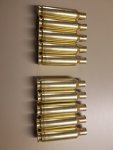When you body size or Fl size a case , you will eventually bump the shoulder.
The shoulder is where the point where the case mouth slopes down and widens to the diameter of the body (hence shoulder).
You start sizing the shoulder when you screw the FL die to the point where the case shoulders make hard contact with the die. (take a look at a google photo of a die cutaway).
so if you screw the die down too much you're sizing your shoulders way too much and you start crushing your die down (think stomping on a coke can).
The proper way to FL size a case is to precisely size the case where you just push the shoulders down 1-2 thousandths of an inch from its fired spec.
That is why you measure a fired case.
Example:
fired case from case head (primer pocket area) to the shoulders measures 3.672" on your comparator tool (40 SW case or Hornady case comparator)
you screw the die down little by little until you size snd messier the sized case at 3.671 or 3.670. (1-2 thousandths bump)
you CANNOT get this measurement by just taking calipers from case head to the case mouth (top of neck) it HAS to be measured at the shoulder area.



